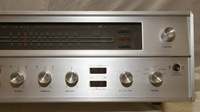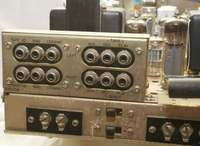
lafayette
LR-800
|

  |
The
Lafayette LR-800 model was a solid construction, which supposed
to offer stereo reception with quality and power comparable to
American products for a smaller price. And it must be said that it
has been achieved. Electronically, the LR800 resembles other
Kenwood products. A correction preamplifier based on two 12AX7 /
ECC83 and a power amplifier based on 6AN8 driver tubes and 7189A /
E84L power tubes are typical systems of this company. Of course,
the power amplifier works in a Push & Pull system with
adjustable bias, but the construction does not allow to change the
bias. Three illuminated eyes on the scale above the function
selector were used to display the selected input function.
Typically for Kenwood, the set of audio inputs and outputs was
also solved in the form of a separate box mounted on the back of
the chassis. The tuner is a very elaborate design. The VHF head
works on one 6CW4 nuvistor and a 6AQ8 / EC85 double tube, ensuring
very good sensitivity and selectivity. After the head, a
four-stage intermediate frequency amplifier terminated with an FM
demodulator on a double 6AL5 / EAA91 vacuum diode. A typical
Kenwood chip, but compared to what was produced in Europe then, it
is a different world. Behind the demodulator there is a stereo MPX
decoder in a matrix system based on germanium diodes. It also
includes two tubes 6BL8 / ECF82 and 6AV6 / EBC91. Something unique
and probably coming from the design of ham receivers is the MPX
stereo recognition system. The receiver had a special "Stereo
Searcher" button which, when pressed, made the loudspeakers hear a
whistle with a frequency of about 1 kHz when tuned to a stereo
broadcasting station. After fine tuning - which was also done by
the tuning indicator on the EM84 tube - the button had to be
released. The same was true of checking the MPX signal in the
KW-44 receiver. Like every Japanese receiver, its 24 tubes were
manufactured by Japanese companies Hitachi, Toshiba, NEC or
Matsutshita. The LR-800 is a very nice-sounding design and at the
same time it presents itself very nicely. The amplifier built on
7189A power pentodes provides enough power to be loud and of good
quality.
   
|
Main
page Previous
page
Contact
Visits